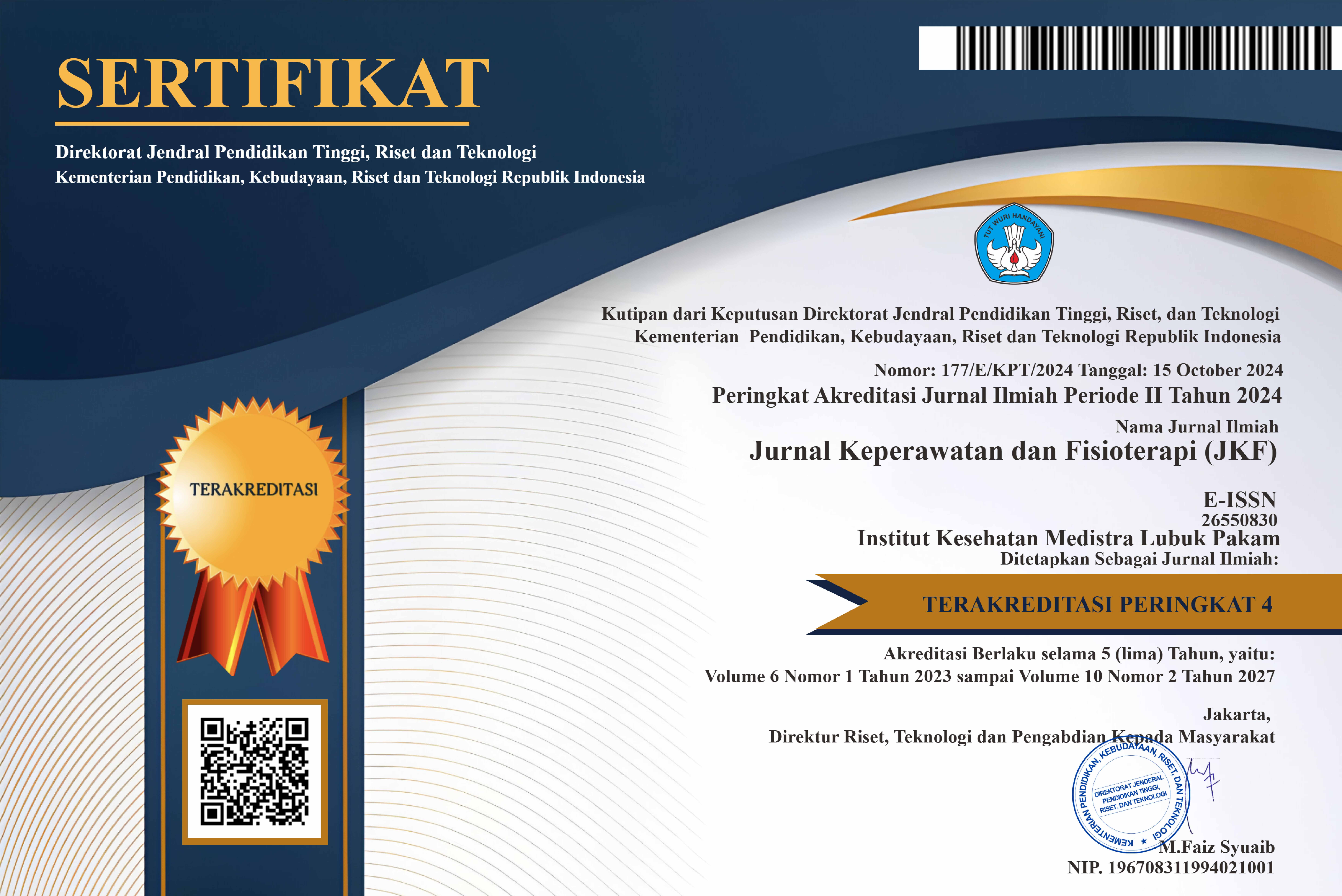The Effect of Early Mobilization on Incerased Intestinal Peristaltic Post Sectio Caesarea at Grandmed Lubuk Pakam Hospital in 2023
DOI:
https://doi.org/10.35451/jkf.v6i2.2120Keywords:
Mobilization, Intestinal Peristaltic, Section CaesareaAbstract
Sectio Caesarea is a surgical process with the aim of removing the fetus through an incision in the abdominal wall which is connected to the autonomic nervous system, so that bowel movements become slow and cause problems. Caesarean section deliveries are increasingly being performed and their success is high, although they are still considered the last solution. Cesarean section operations are common for mothers who are about to give birth. So that post-operative intestinal peristalsis can return immediately, mobilization is necessary. If there is no mobilization, the motility function of the intestines and bladder will take a long time to return to normal so that the mother will have difficulty defecating. This research aims to measure how much mobilization increases intestinal peristalsis in post-caesarean section surgery patients. The research is quantitative research with a One Group pre-post test design. The sample consisted of 25 post-cesarean section mothers with primigravida births. The instruments used are SOP sheets and observations. Data analysis using the Paired T-test with an error of 0.05 showed that the average intestinal peristalsis before the intervention was 7.20 while after the intervention it was 8.04. The results of the Paired T-test show that the p-value is 0.000, which means that there is an effect of mobilization on increasing intestinal peristalsis in post caesarean section patients at GrandMed Lubuk Pakam Hospital. It is recommended that you always implement post caesarean section mobilization measures in accordance with the SOP.
Downloads
References
Ambarwati, E.R. (2017). Asuhan Kebidanan Komunitas. Yogyakarta: Nuha Medika
Daru, E. 2015. Jurnal Ilmiah Tentang Pengaruh Mobilisasi Dini ROM Pasif Terhadap Pemulihan Peristaltik Usus Pada Pasien Paska Pembedahan Dengan Anastesi Umum Di SMC Rs Telogorejo.
Delima, M., Kalpana, K.,Dewi, D. (2019). Pengaruh Pengaturan Posisi Terhadap Lama Pemulihan Keadaan Pasien Post Operasi Dengan Anastesi Umum. Jurnal Kesehatan Perintis. Vol. 6, No. 1 (36)
Dewi, Niluh Liana. 2017. Skripsi Pengaruh Mobilisasi Dini terhadap Pemulihan Peristaltik Usus pada Pasien Post Operasi dengan Narkose Umum. Magetan.
Fitriani, N. L., & Anggorowati, A., (2017). Hubungan tingkat stes dengan pelaksanaan mobilisasi dini pada ibu post partum normal.Diponegoro University.
Indiarti, M.T 2017.Caesar, Mengapa Tidak ? Cara Aman Menyambut Kelahiran Buah Hati Anda.Yogyakarta : Elmatera Publishing.
Joko, P. 2017. di akses pada 5 februari 2017. Jurnal Ilmiah Tentang Hubungan Ambulasi Dini Terhadap Aktivasi Peristaltik Usus Pada Pasien Post Operasi Fraktur Ekstremitas Bawah Dengan Anestei Umum Di Ruang Mawar II RS. DR Moewardi Surakarta.
Kehlet, H. 2015. Review Postoperative Ileus- An Update on Preventive Techniques. Nature Clinical Practice Gatroenterology and Hepatology October 2008 Vol.5 No. 10
Ledari, F. M., Barat, S., Delavar, M. A., Banihosini, S. Z., & Khafri, S., 2017. Chewing sugar-free gum reduces ileus after cesarean section in nulliparous women: a randomized clinical trial. Iranian Red Crescent Medical Journal,15(4), 330.
Long, Barbara C. 2017. Perawatan Medikal Bedah Volume 2. Bandung: Ikatan Alumni Pendidikan Keperawatan Pajajaran Bandung.
Majid, A dkk. 2017. Keperawatan Perioperatif. Yogyakarta : Gosyen Publishing
Mochtar, R. 2013. Sinopsis Obstetri Obstetri Operatif Obstetri Sosial Edisi 2. Jakarta : EGC
Narko, Wiyono & Siti Arifah. 2017. Pengaruh Ambulasi Dini terhadap Pemulihan Peristaltik Usus Pasien Pasca Operasi Fraktur Femur.
Nora, S., Wiwik, L., Nur, A., Lela, R., Patimah, S.S.(2020). Pengaruh Mobilisasi Dini Terhadap Suara Peristaltik Usus Pada Pasien Post Operasi Appendectomy. Manuju : Malahayati Nursing Journal Volume 2. No. 3(596)
Notoatmodjo, S. 2016. Metodologi Penelitian Kesehatan, Jakarta : Rineka Cipta.
Patricia dan Sally.2016. Asuhan Keperawatan Ibu-Bayi Baru Lahir.Jakarta : EGC.
Pearce, E. 2017.Anatomi Dan Fisiologi Untuk Paramedis. Jakarta : PT Gramedia Pustaka Utama.
Prawirohardjo, S (2018) Ilmu kebidanan . Jakarta : PT Bina Pustaka Sarwono
Price dan Wilson. 2017. Patofisiologi : Konsep Klinis Proses – Proses Penyakit, Edisi 6, Volume 1. Jakarta : EGC.
Rekam medis dan informasi kesehatan Rumas Sakit Grandmed Lubuk Pakam Tahun 2023.
Renggonowati, A, 2018. Pengaruh Mobilisasi Dini Terhadap Peristaltik Usus Pasca Operasi Sesar Dengan Anastesi Spinal Di Rsud Tugurejo Semarang. Jurnal Ilmu Keperawatan dan Kebidanan, 1(6).
Reni, A. (2018). Pengaruh PenyuluhanManfaat Mobilisasi Dini Terhadap Pelaksanaan Mobilisasi Dini Pada Pasien Pasca Laparatomi. Syntax Literate. Vol. 3, No.2 (109)
Riskesdas. (2018). Hasil Utama Riset Kesehata Dasar (Riskesdas) (Vol. 44, Issue 8). https://doi.org/10.1088/1751- 8113/44/8/085201.
Setiadi. 2017. Anatomi Dan Fisiologi Manusia. Yogyakarta : Graha Ilmu.
Sihombing, N (2017) Determinan Persalinan Sektio Caesarea di Indonesia. Jurnal Kesehatan Reproduksi.
Sloane, E. 2016.Anatomi Dan Fisiologi Untuk Pemula. Jakarta : EGC.
Sumaryati, S., Widodo, G. G., & Purwaningsih, H. (2018). Hubungan Mobilisasi Dini dengan Tingkat Kemandirian Pasien Post Sectio Caecarea di Bangsal Mawar RSUD Temanggung. Indonesian Journal of Nursing Reasearch, 1(1), 20–28. http://jurnal.unw.ac.id:1254/inde x.php/ijnr/article/view/8
Suryani dan Anik.2017 . Asuhan Keperawatan Ibu Post Partum Seksio Sesarea. Jakarta : CV Trans Info Media.
Downloads
Published
Issue
Section
License
Copyright (c) 2024 Juni Mariati Simarmata, Syatriawati Syatriawati, Della Padila

This work is licensed under a Creative Commons Attribution 4.0 International License.
Copyright in each article is the property of the Author.


























